Instruments used in general medicine
| Instrument | Uses |
|---|---|
| Bedpan | for patients who are unconscious or too weak to sit up or walk to the toilet to defecate |
| Cannula | to create a permanent pathway to a vein (or artery) for the purpose of repeated injections or infusion of intravenous fluids |
| Cardioverter / Defibrillator | to correct arrhythmias of the heart or to start up a heart that is not beating |
| Catheter | to drain and collect urine directly from the bladder (primary use); also to act as a makeshift oxygen tube, etc. |
| Dialyser | to remove toxic materials from the blood that are generally removed by the kidneys; used in case of kidney failure |
| Electrocardiograph machine | to record the electrical activity of the heart over a period of time |
| Enema equipment | to inject fluid into the lower bowel for several purposes, most frequently for relieving constipation |
| Endoscope | to look inside the gastrointestinal tract, used mainly in surgery or by surgical consultants |
| Gas cylinder | as a supply of oxygen, nitrous oxide, carbon dioxide, etc. |
| Gauze sponge | to absorb blood and other fluids as well as clean wounds |
| Surgical scissors | used for dissecting or cutting |
| Hypodermic needle / Syringe | for injections and aspiration of blood or fluid from the body |
| Infection control equipment | as in gloves, gowns, bonnets, shoe covers, face shields, goggles, and surgical masks for preventing nosocomial or healthcare-associated infection |
| Instrument sterilizer | to sterilize instruments in absence of an autoclave |
| Kidney dish | as a tray for instruments, gauze, tissue, etc. |
| Measuring tape | for length, height, head circumference and girth measurements |
| Medical halogen penlight | to see into the eye, natural orifices, etc. and to test for pupillary light reflex, etc. |
| Medical ultrasound | to create an image of internal body structures |
| Nasogastric tube | for nasogastric suction or the introduction of food or drugs into the body |
| Nebulizer | to produce aerosols of drugs to be administered by respiratory route |
| Ophthalmoscope | to look at the retina |
| Otoscope | to look into the external ear cavity |
| Oxygen mask and tubes | to deliver gases to the mouth/nostrils to assist in oxygen intake or to administer aerosolized or gaseous drugs |
| Pipette or dropper | to measure out doses of liquid, specially in children |
| Proctoscope | to look inside the anal canal and lower part of the rectum |
| Radiography | to view internal body structures |
| Reflex hammer | to test motor reflexes of the body |
| Sphygmomanometer | to measure the patient's blood pressure |
| Stethoscope | to hear sounds from movements within the body like heart beats, intestinal movement, breath sounds, etc. |
| Suction device | to suck up blood or secretions |
| Thermometer | to record body temperature |
| Tongue depressor | for use in oral examination |
| Transfusion kit | to transfuse blood and blood products |
| Tuning fork | to test for deafness and to categorize it |
| Ventilator | to assist or carry out the mechanical act of inspiration and expiration so the non-respiring patient can do so; a common component of "life support" |
| Watch / Stopwatch | for recording rates like heart rate, respiratory rate, etc.; for certain hearing tests. |
| Weighing scale | to measure weight |
| Crocodile Forceps | to remove foreign bodies from ear or nasal cavities. |
Image gallery
 Bandage
Bandage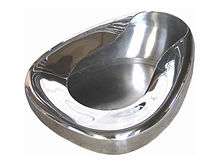 Bedpan
Bedpan Blood infusion set
Blood infusion set Cannula, intraveneous (separated)
Cannula, intraveneous (separated) Catheter, Foley
Catheter, Foley Defibrillator
Defibrillator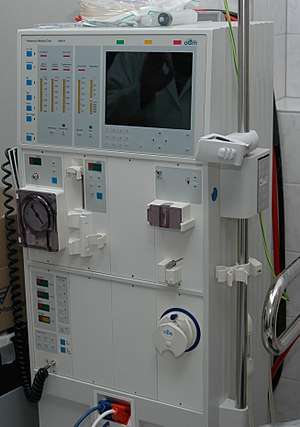 Dialyser, hemodialysis
Dialyser, hemodialysis Enema bag and enema bucket
Enema bag and enema bucket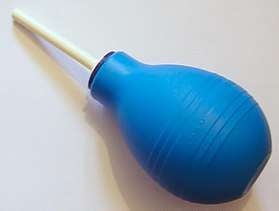 Enema bulb
Enema bulb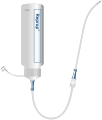 Enema set
Enema set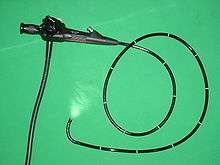 Endoscope
Endoscope Face shield
Face shield- Gas cylinder, oxygen
- Gauze sponges
- Instrument sterilizer
 Kidney dish
Kidney dish- Medical halogen penlight
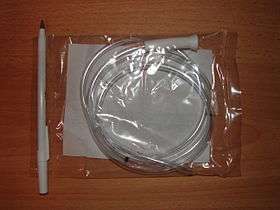 Nasogastric tube, Levin
Nasogastric tube, Levin Nebulizer
Nebulizer- Ophthalmoscope
 Reflex hammer
Reflex hammer Reflex hammer, queen square
Reflex hammer, queen square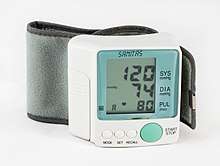 Sphygmomanometer, electronic
Sphygmomanometer, electronic Stethoscope
Stethoscope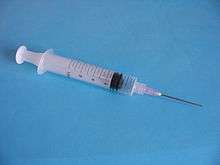 Syringe and needle
Syringe and needle Thermometers, mercury
Thermometers, mercury Tongue depressors
Tongue depressors Tuning fork
Tuning fork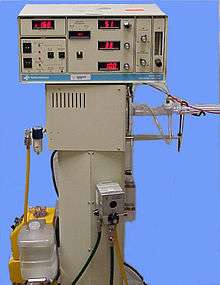 Ventilator, high-frequency
Ventilator, high-frequency Weighing scale
Weighing scale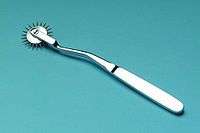 Wartenbergwheel
Wartenbergwheel
gollark: +>markov
gollark: +>markov
gollark: +>markov
gollark: +>markov
gollark: ++remind 7mo3w Apiohazard of class μ.
References
Ankushroy
This article is issued from Wikipedia. The text is licensed under Creative Commons - Attribution - Sharealike. Additional terms may apply for the media files.